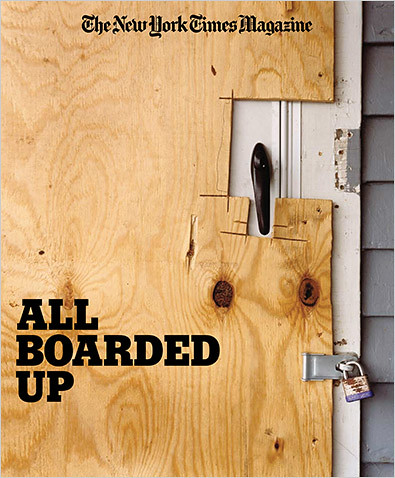What happens when 1 out of 13 houses in your city is abandoned? In today's New York Times Magazine - All Boarded Up by Alex Kotlowitz- tells Cleveland's story.
Attorney Sheree Meadows specializes in housing issues and represents low income homeowners here in Buffalo, NY. She recently sat down with me and described dozens of stories dealing with some of country's largest banks in Housing Court. According to Sheree there are hundreds of cases in Buffalo where the bank or lending institution will initiate a foreclosure proceeding and never complete it. In the meantime, the owner will move out - fully expecting the bank to take over the property - and later after being summoned to Housing Court learn that they're still responsible for what's left of the vacant property.
In such cases - Cleveland or in Buffalo - the residual value of the property has gone from being an asset to a liability. All Boarded Up is a must read if you're interested in knowing just how far public policy has to go to catch up to the existing reality of life on the streets in a city like ours.
See also:
__________________________________________________________________________Officials in Cleveland are grappling with at least 10,000 abandoned homes, many owned by lenders or speculators who trade them like baseball cards.Buffalo NY is grappling with vacancy and abandonment and has a higher percentage of vacant property than any other city in the country, except St. Louis. The foreclosure crisis in Cleveland and how it intersects with banks not completing the process and re-taking title to a house as described in today's New York Times is not isolated to Cleveland. The same series of events plays out here in Buffalo everyday.
Attorney Sheree Meadows specializes in housing issues and represents low income homeowners here in Buffalo, NY. She recently sat down with me and described dozens of stories dealing with some of country's largest banks in Housing Court. According to Sheree there are hundreds of cases in Buffalo where the bank or lending institution will initiate a foreclosure proceeding and never complete it. In the meantime, the owner will move out - fully expecting the bank to take over the property - and later after being summoned to Housing Court learn that they're still responsible for what's left of the vacant property.
In such cases - Cleveland or in Buffalo - the residual value of the property has gone from being an asset to a liability. All Boarded Up is a must read if you're interested in knowing just how far public policy has to go to catch up to the existing reality of life on the streets in a city like ours.
See also:
- Housing Court in Cleveland - 9/2006
- Dirty Deeds & Toxic Title - 1/2008
Artspace • BAVPA • Woodlawn Row Houses • fixBuffalo flickr
Creative Class • Shrinking Cities • Saturdays in the neighborhood


4 comments:
Interestingly, one of the photos that accompanies the article shows a reasonably handsome detached house not unlike many you have depicted on FixBuffaloToday -- not the too-small-to-be-practical houses referred to in the text. The other photo was of a semidetached twin of quite interesting style.
Even with regard to the too-small category, an unexplored question is whether in an era of diminished expectations, a neighborhood of too-smalls can be made attractive again to the working class, such as it is these days. What would it take?
I concede this is less of a problem in Cleveland and Buffalo than in places like Philadelphia, Baltimore and the smaller cities of the mid-Atlantic states, which once specialized in two-story fully attached rowhouses, now considered impractical for anyone but squatters and the impoverished elderly. Typically, the 3-story rowhouses can be saved with the right support, but not the 2s.
I think your blog requires a clear, up-front restatement of what your vision is for "rebuilding" Bflo : if not demolition and greenfield reconstruction a la suburban tract, then what -- specifically? I'm not doubting you have that vision; I just think it needs to be articulated and posted on the front page prominently and indefinitely as a reminder of what the city administration does not appear to be doing.
David,
Smaller, more energy efficient, houses are in demand or could be if marketed properly once all the costs associated with housing are considered. For the working class or creative class, innovative spaces that are efficient and well designed, haven't been brought to the market here in Buffalo.
Perhaps what you are referring to in other areas - Philadelphia and Baltimore - has something to do with the respective city's demolition plans.
Thanks for the reminder.
David
Was that tiny house on Ashland a "working class" endeavor?
I have been a landlord in buffalo for 23 years. All of this abandon property was landlords who rented it to people on welfare and then had the rent money spent on big bottles of beer,lottery tickets,drugs,when they complained to deb merrifield,the comissioner of social services in the 90s she refered them to patrick henry who said theres nothing much we can do if our clients dont pay the rent.I dont understand why all you activists dont go after the true culprits in this housing mess.i will never invest in a low income neigborhood again even though i am quite capable of rehabbing buildings
Post a Comment